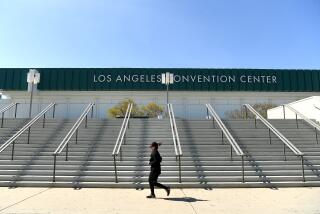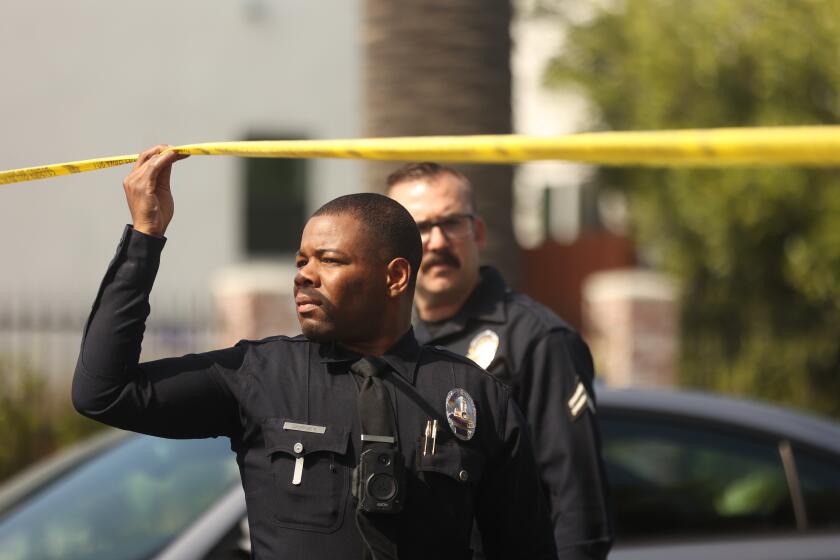A Price Tag That Grew and Grew : Beverly Hills: City Manager Mark Scott says the new Civic Center cost far more than expected because officials failed to watch the bottom line.
- Share via
Nine years and $121 million later, Beverly Hills is starting to come to terms with the cost of its lavish new Civic Center, originally estimated at a quarter of the price.
In a report released to the City Council Tuesday night, City Manager Mark Scott said his five-month investigation found that decision-makers failed from the start to keep their eyes on the bottom line.
Obsessed with building a Taj Mahal of the Westside, they found themselves saddled with costs that relentlessly escalated and could not be stopped without undermining the project’s basic architectural concepts.
For example, the arched rotunda spanning Rexford Drive, the heart of architect Charles Moore’s Italianate design, was part of a group of outdoor structures whose cost was “dramatically underestimated” at $2 million by Moore’s own consultant, the report found.
“When the real costs ($14 million) of these elements were understood, it was far too late to make major changes,” Scott said.
Failure to check the old library building for asbestos also caused “serious delays and additional costs.” So did a decision to dig foundations for the police station so deep that the excavation became a mudhole.
The report named no culprits. But Scott, who was named to the city’s top job when his predecessor retired under fire earlier this year, said that a separate investigation by a team of lawyers and accountants may lead to legal action.
For the future, Scott urged the City Council to develop a “tolerance for bad news . . . so you can find out what’s wrong and do something about it.”
Excluding a separate $12 million contract for renovating the 59-year-old City Hall, Scott’s report found a $109.1-million bottom line for the costs of building the Civic Center. As recently as November, 1989, City Council members were told that the total would be $14 million less.
The latest estimate includes $27.6 million for the police station, $21 million for the library, $9.3 million for the fire headquarters, $8.5 million for parking and $14 million for outdoor work including an amphitheater and Moore’s soaring concrete arches.
Other costs include a $6 million security and communications system for the Police and Fire departments.
Poring over old reports and other archival data, Scott said, he felt like “an archeologist and historian,” turning up “twists and turns that would probably put ‘Twin Peaks’ to shame.”
The Mexican Baroque-styled City Hall has towered over Santa Monica Boulevard since 1931, but civic-minded individuals started talking about a more elaborate complex in the 1960s, Scott said.
Concerned about the cramped quarters of the Police Department and library, and worried that the old fire station would not survive an earthquake, the City Council hired a consultant in 1981 to report on the city’s needs for space.
A design competition followed, calling for architects to come up with a civic center that would also include an ill-defined, 25,000-square foot “Community Cultural Complex.”
That concept eventually emerged as a proposal for a full-fledged community theater before it was cut to save money, but when a design jury chose Moore’s proposal in 1982, the $30 million price tag seemed easily affordable.
“The $30 million figure that was estimated was a very early, preliminary figure,” Scott stressed, saying that other costs, such as architectural and engineering fees, brought the first real estimate up to $36.5 million.
Although it chose Moore’s design, the jury composed of prominent architects and scholars took pains to add some recommendations of its own that were sure to raise the cost.
For example, the jury urged that Moore’s “new spaces of great richnesses” be executed “finely and in enduring materials,” not the stucco that Moore originally suggested.
“As the design develops, pressures will mount to make further economies. The central rotunda must not be eliminated or much reduced in scale or quality. Without it, the design has no heart,” the jury said.
As Scott read that excerpt Tuesday night, City Council members interjected snorts of sardonic laughter, knowing that the concrete casting needed to make the rotunda had proven to be one of the most problematic and expensive parts of the job.
“I want to make it perfectly clear that this was well before the time any of us was on the Council,” said Councilman Max Salter.
“I was in college at the time,” joked Councilman Robert K. Tanenbaum (who, in fact, graduated from UC Berkeley in the mid-1960s).
An assumption that city workers would not have to move to temporary quarters during construction also proved to be “extremely naive and costly,” Scott said.
Unsatisfied with Moore’s estimate, the city took another look at the project, added several millions to upgrade the exterior and make other improvements, and came up with its first genuine budget for the project in 1984--$65.3 million.
It was then that the fire station and parking structure went out to bid. In retrospect, Scott said, “there is no question that proceeding with these elements made it more difficult to adjust” as the theater was dropped, the arch work bogged down and departmental needs evolved over time.
“The Civic Center project suffered continually from ‘fast-track’ processes and from failure to set clear, up-front objectives,” he concluded. “Options were limited because previous phases had been initiated already. In many instances, budgets did not precede design, they followed them.”
The theater was dropped in 1985, a difficult decision that was expected at the time to save about $10 million.
After a long redesign process, the City Council voted in late 1986 to award the contract to finish the job to the J. A. Jones Construction Co. of North Carolina.
It was during Jones’ contract that the asbestos and ground-water problems surfaced, but Scott said that possible legal problems made it difficult for him to go into too much detail about the last two years of the project.
“It’s been suggested to me that it’s not a topic I should spend a lot of time talking about,” he said.
As he spoke, City Councilman Bernard J. Hecht broke in to say, “They never had an asbestos inspection!” but he was shushed by his colleagues.
Between 1987 and the end of 1989, the construction cost of the final phase--the library, the police station and the outdoor structures--rose from the Jones company’s $43.6 million original bid to roughly $53 million in November of last year, but “staff wishes to be cautious in characterizing case and responsibility,” Scott said.
As of now, he said, it should cost another $14.5 million to finish the project, but differences with Jones over more than 500 change orders could affect the final cost.
Tanenbaum, who campaigned against the large scale of the Civic Center when he was first elected in 1986, recalled that his proposal to scale it down was outvoted shortly after he took office.
He said that “negligent, incompetent, bureaucratic behavior” led to the excesses of the Civic Center.
“But it has its positive side,” he said, comparing it to the Eiffel Tower in Paris, which was highly controversial when it was built.
“Fifty years from now, people are going to say, ‘What a bright group of people they must have been to build these beautiful buildings,’ ” Salter added.
“People will come to see it,” Salter said. “They won’t have to go to the Vatican. We’ve got it here.”
More to Read
Sign up for Essential California
The most important California stories and recommendations in your inbox every morning.
You may occasionally receive promotional content from the Los Angeles Times.













